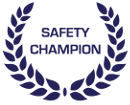If you don’t know what a toolbox talk is it’s likely you don’t work in a blue-collar-type role. Because in industries like construction, mining, warehousing, manufacturing, right through to landscaping, toolbox talks are an integral part of health and safety program and procedures.
That said, if you run a business or manage people in or outside of these industries and don’t know what a toolbox talk is… read on. Then consider integrating these into your own safety management system – the benefits can be outstanding.
Why? Because toolbox talks can be a great way for any manager or team leader to start conversations about safety in the workplace!
So, what are they?
Toolbox talks are short and regular meetings about safety issues relevant to a specific site, project or workplace. A manager, supervisor or health and safety representative usually runs them with all person on site prior to a shift, at the commencement of a particular part of a project, or simply on a regular basis.
So yes, toolbox talks are sort of like meeting. In white-collar workplaces these are often just what you’d call a team meeting.
In addition to site, project or workplace specific hazards, toolbox talks will often cover organisational-specific safety topics including; key definitions, reminders about established controls, and importantly, actions/tasks scheduled to be taken by the people in the team to ensure that work is undertaken safely.
Why have them?
In short, their purpose is to ensure the whole team understand and keep the correct health and safety practices in mind as they go about their work. They keep health and safety front-of-mind and raise awareness about a safety issues.
And because any given site or project may have different or changing safety hazards, it’s important they are held regularly and involve everyone. This helps builds that safety-first culture, and a physiologically safe workplace, where workers are provided with a safe environment to raise questions that they may have.
What is a common structure?
Often toolboxs talks these days will be less like a lecture or meeting, and more like an interactive discussion where everyone can and should raise their hands to be involved. What you want is for your team to be engaged, to have their concerns addressed, and to ensure that everyone walks away with a clear understanding of that safety topic and how it implicates them in their day-to-day work.
A question-answer type structure is a good way to run toolbox talks. You ask the team for their involvement and answer their questions, but at the same time have a few common questions with considered answers ready to go.
Should I hold toolbox talks?
We’re gonna say YES! Regardless of the industry you work in toolbox talks are a great way to discuss get the discussion moving around common hazards in your workplace.
And if you are thinking, “I work in an office – there are no hazards here,” think again. Every workplace has hazards – it may just be that the frequency that your toolbox meetings take place is adjusted. Workers have the right to know what those hazards are and how to management them – and it’s your responsibility to ensure that they have everything they need to be healthy and safe in the workplace!
How can I get my hands on some templates?
We’re glad you asked! Simply fill out this form, let us know what you think you need, and we’ll be in contact to help you out with some common toolbox talk templates that are relevant for your industry!




